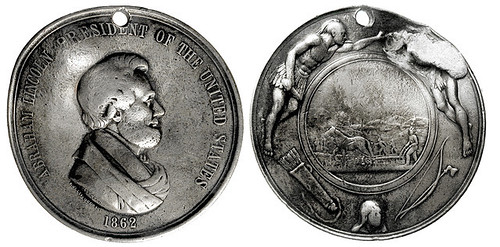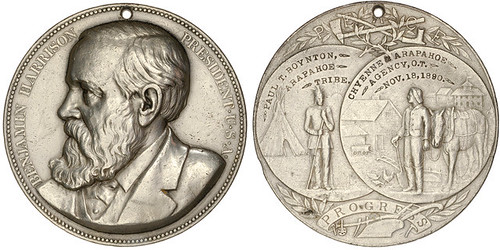
PREV ARTICLE
NEXT ARTICLE
FULL ISSUE
PREV FULL ISSUE
V25 2022 INDEX E-SYLUM ARCHIVE INDIAN PEACE MEDALS AT THE ANSAn ANS Pocket change blog article by Oliver Hoover examines the Indian Peace Medals at the ANS. Here's an excerpt - see the complete article online. -Editor The Dead Zone was a popular science fiction thriller written by Stephen King in 1979 that was made into a movie starring Christopher Walken in 1983. It tells the story of a man who discovers that he has the ability to see visions of the future when he touches objects that belong to another person. The Indian Peace Medal collection of the American Numismatic Society is kind of like that. When you work with these medals, look at them on a frequent basis, and have the opportunity to hold them in your hand, they never fail to call up visions of their original owners and of the specific pasts that they experienced.
Don't get me wrong. Coins are great. The ANS is filled to the brim with coins that have fascinating stories to tell. However, except for specimens obtained straight from the mint, most coins circulated through many hands in commerce before coming to rest in the Society's collection, and most of those hands belong to nameless and faceless individuals. The Indian Peace Medals are very different in this regard. They were given to specific people, many of whose names can still be found in various forms on U.S. and Canadian treaty documents of the nineteenth century. As such, the medals serve as relics for communing with their original Native American recipients and in a few cases the specific fur traders (John Lawe and Pierre Chouteau) who may have distributed them. The Indian Peace Medals in the collection are also especially powerful because, with the exception of a King George III medal very doubtfully associated with Tecumseh (Fig. 1), the vast majority that are attributed to their original owners by name are not linked to famous None of the medals are said to have belonged to the larger-than-life figures of Black Hawk (Mahkate:wi-meši-ke:hke:hkwa), Sitting Bull (T?at?á?ka Íyotake) or Crazy Horse (T?ašú?ke Witkó). Instead, they belonged primarily to somewhat lesser flesh-and-blood leading men trying to negotiate futures for themselves and their people in a North America that was changing forever.
Figure 2. Abraham Lincoln Indian Peace Medal attributed to Honkapkna (
Honko) with embedded bullet. Perhaps the most famous Indian Peace Medal in the ANS collection with a recipient's name attached to it is the large Abraham Lincoln medal that saved its owner from a gunshot (Fig. 2). It is said to have belonged to a nineteenth-century Ute (Núuchi) leader named Honkapkna (often reduced to Honko or Unco in contemporary sources) associated with the White River Ute Indian Agency in Colorado.
To read the complete article, see:
Wayne Homren, Editor The Numismatic Bibliomania Society is a non-profit organization promoting numismatic literature. See our web site at coinbooks.org. To submit items for publication in The E-Sylum, write to the Editor at this address: whomren@gmail.com To subscribe go to: https://my.binhost.com/lists/listinfo/esylum All Rights Reserved. NBS Home Page Contact the NBS webmaster 
|



